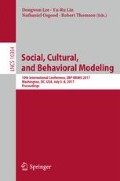Abstract
To address the rising tide of religious violence as it affects U.S. Military deployments, the Army requires analytic methods that can be generalized to predict religious group violence around the globe and scalable to the number of potential groups in an area of operation. Current computational methods based on semantics and topics are lacking in predictive performance for the generalized problem and topic modeling performs poorly in predicting the tolerance level of new groups towards U.S. Military presence. The research in this paper aims to discover the association between religious speech and behaviors and provide a foundation for proactive engagement with these groups. The approach builds on the work from ethnolinquistics to model how things are said (performative analysis) rather than word meanings (semantic analysis). Recent research has developed computational approaches to streamline the manually intensive performative analysis of religious text. While producing promising results, these computational methods lack systematic optimization of the hyperparamters in the learning algorithms. Hence, we do not know the sensitivity of the results to parameter settings. This paper reports on results for predicting religious tolerance by optimizing the parameters in the signal processing algorithms and shows that the predictive power of performative approach is robust to parameter settings.
Access this chapter
Tax calculation will be finalised at checkout
Purchases are for personal use only
References
Abu-Nimer, M.: Conflict resolution, culture, and religion: toward a training model of interreligious peacebuilding. J. Peace Res. 38(6), 685–704 (2001)
Barsalou, L.: Flexibility, structure, and linguistic vagary in concepts: manifestations of a compositional system of perceptual symbols. Theor. Mem. 1, 29–31 (1993)
Blatter, B., Patel, V.: Exploring dangerous neighborhoods: latent semantic analysis and computing beyond the bounds of the familiar. In: AMIA 2005 Symposium Proceedings, pp. 151–155 (2005)
Boussidan, A., Ploux, S.: Using topic salience and connotational drifts to detect candidates to semantic change. In: Proceedings of the Ninth International Conference on Computational Semantics, pp. 315–319. Association for Computational Linguistics (2011)
Bullinaria, J.A., Levy, J.: Extracting semantic representations from word co-occurrence statistics: stop-lists, stemming, and SVD. Behav. Res. Methods 44(3), 890–907 (2012)
Cook, P., Stevenson, S.: Automatically identifying changes in the semantic orientation of words. In: LREC (2010)
Csardi, G., Nepusz, T.: The igraph software package for complex network research. InterJ. Complex Syst. 1695(5), 1–9 (2006)
Estrada, E., Rodriguez-Velazquez, J.A.: Subgraph centrality in complex networks. Phys. Rev. E 71(5), 056103 (2005)
Hassner, R.E.: War on Sacred Grounds. Cornell University Press, Ithica (2009)
Loper, E., Bird, S.: NLTK: the natural language toolkit. In: Proceedings of the ACL-02 Workshop on Effective tools and methodologies for teaching natural language processing and computational linguistics, vol. 1, pp. 63–70. Association for Computational Linguistics (2002)
Marcus, B.: Global covenant of religion. (2015). https://sites.google.com/a/globalcovenant.org/global-covenant/team
Ochs, P.: The possibilities and limits of inter-religious dialogue. In: Omer, A., Appleby, R.S., Little, D. (eds.) Religion, Conflict, and Peacebuilding, pp. 488–534. Oxford University Press, New York (2015)
Sagi, E., Kaufmann, S., Clark, B.: Semantic density analysis: Comparing word meaning across time and phonetic space. In: Proceedings of the Workshop on Geometrical Models of Natural Language Semantics, pp. 104–111. Association for Computational Linguistics (2009)
Tompkins, P.J.: Human factors considerations of undergrounds in insurgencies. U.S. Army Special Operations Command, Ft. Bragg, NC, January 2013
United States Special Operations Command: Gray zone, September 2015. https://info.publicintelligence.net/USSOCOM-GrayZones.pdf
Venuti, N., Sachtjen, B., McIntyre, H., Mishra, C., Hays, M., Brown, D.E.: Predicting the tolerance level of religious discourse through computational linguistics. In: 2016 IEEE Systems and Information Engineering Design Symposium (SIEDS), pp. 309–314. IEEE Press (2016)
Yang, M., Wong, S., Coid, J.: The efficacy of violence prediction: a meta-analytic comparison of nine risk assessment tools. Psychol. Bull. 136(5), 740 (2010)
Author information
Authors and Affiliations
Corresponding author
Editor information
Editors and Affiliations
Rights and permissions
Copyright information
© 2017 Springer International Publishing AG
About this paper
Cite this paper
Brown, D.E., McIntyre, H., Grazaitis, P.J., Hazell, R.M., Venuti, N. (2017). Hyperparameter Optimization for Predicting the Tolerance Level of Religious Discourse. In: Lee, D., Lin, YR., Osgood, N., Thomson, R. (eds) Social, Cultural, and Behavioral Modeling. SBP-BRiMS 2017. Lecture Notes in Computer Science(), vol 10354. Springer, Cham. https://doi.org/10.1007/978-3-319-60240-0_41
Download citation
DOI: https://doi.org/10.1007/978-3-319-60240-0_41
Published:
Publisher Name: Springer, Cham
Print ISBN: 978-3-319-60239-4
Online ISBN: 978-3-319-60240-0
eBook Packages: Computer ScienceComputer Science (R0)

